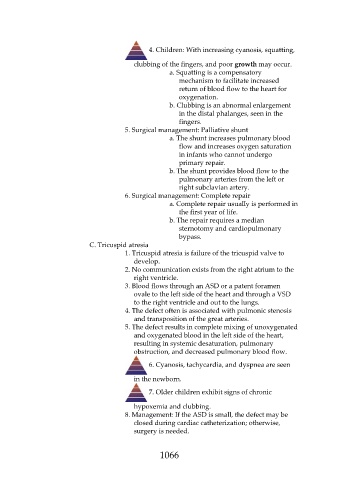Page 1066 - Saunders Comprehensive Review For NCLEX-RN
P. 1066
4. Children: With increasing cyanosis, squatting,
clubbing of the fingers, and poor growth may occur.
a. Squatting is a compensatory
mechanism to facilitate increased
return of blood flow to the heart for
oxygenation.
b. Clubbing is an abnormal enlargement
in the distal phalanges, seen in the
fingers.
5. Surgical management: Palliative shunt
a. The shunt increases pulmonary blood
flow and increases oxygen saturation
in infants who cannot undergo
primary repair.
b. The shunt provides blood flow to the
pulmonary arteries from the left or
right subclavian artery.
6. Surgical management: Complete repair
a. Complete repair usually is performed in
the first year of life.
b. The repair requires a median
sternotomy and cardiopulmonary
bypass.
C. Tricuspid atresia
1. Tricuspid atresia is failure of the tricuspid valve to
develop.
2. No communication exists from the right atrium to the
right ventricle.
3. Blood flows through an ASD or a patent foramen
ovale to the left side of the heart and through a VSD
to the right ventricle and out to the lungs.
4. The defect often is associated with pulmonic stenosis
and transposition of the great arteries.
5. The defect results in complete mixing of unoxygenated
and oxygenated blood in the left side of the heart,
resulting in systemic desaturation, pulmonary
obstruction, and decreased pulmonary blood flow.
6. Cyanosis, tachycardia, and dyspnea are seen
in the newborn.
7. Older children exhibit signs of chronic
hypoxemia and clubbing.
8. Management: If the ASD is small, the defect may be
closed during cardiac catheterization; otherwise,
surgery is needed.
1066

